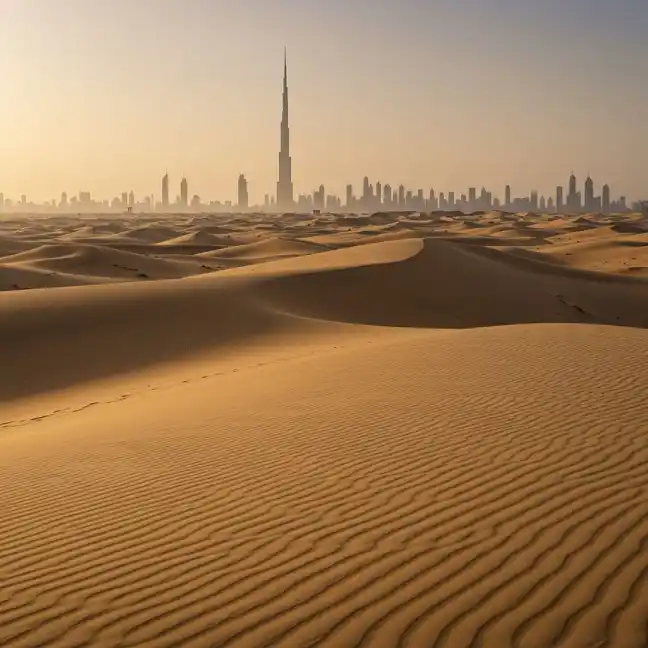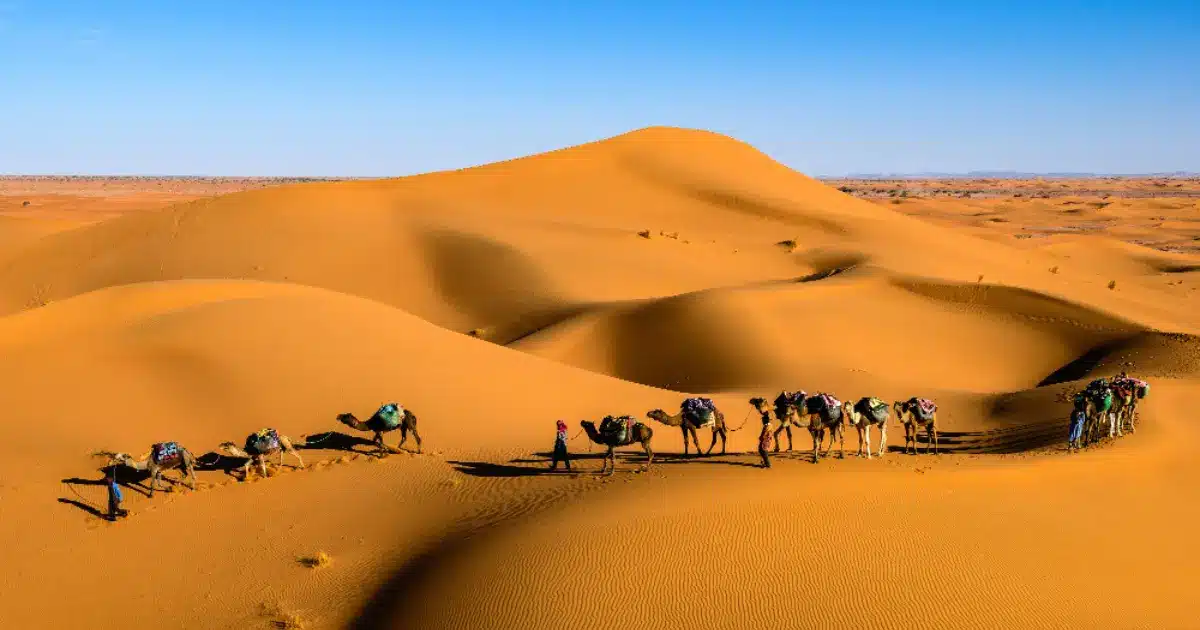Dubai is often celebrated for its glittering skyscrapers, luxury malls, and futuristic innovations. But just beyond the cityscape lies a stark and equally fascinating environment—Dubai’s desert landscape.
In 2025, as sustainable travel and eco-conscious tourism grow in popularity, there has never been a better time to delve deep into the ancient sands that shaped this remarkable city.
From unique geological features to thriving desert ecosystems, Dubai’s desert is a hidden world waiting to be explored.
Formation and Geological History of Dubai’s Desert

The story of Dubai’s desert landscape begins millions of years ago. The region was once submerged under an ancient ocean.
As the waters receded, wind and time sculpted a sweeping expanse of sand and rock, giving birth to the vast Arabian Desert.
The most common features in this terrain are the rolling dunes, formed by wind action over millennia. Dubai’s desert includes various types of dunes such as:
- Linear dunes: Long ridges that run parallel to the prevailing wind
- Crescent or barchan dunes: Shaped like a crescent moon
- Star-shaped dunes: Rare and formed by multidirectional winds
Dubai’s desert landscape also includes sabkhas (salt flats), gravel plains, and fossilized marine beds. This complex geography adds to the mystique and scientific interest in Dubai’s desert regions.
Climate and Weather Patterns in the Desert
Dubai’s desert landscape is defined by its arid, extreme climate. In the summer, temperatures soar past 45°C (113°F), while winter nights can drop below 10°C (50°F).
Sandstorms are a frequent phenomenon, caused by strong northwesterly winds known as “Shamal.” These storms shift the shape of dunes, affect visibility, and play a role in maintaining the desert’s dynamic nature.
Interestingly, climate change is subtly altering these patterns. Winters are becoming slightly milder, and the rainy season has shifted in timing, influencing how plants and animals adapt in the region.
Also read: Shuweihat Island: Abu Dhabi
The Unique Desert Ecosystem in Dubai
Often perceived as barren, the Dubai’s desert landscape is anything but lifeless. Beneath the sun-scorched surface lies an intricate web of life that has adapted to survive with minimal water and searing temperatures.
- Water conservation is critical. Many plants have developed deep root systems and thick leaves to store moisture.
- Animals such as reptiles and small mammals are nocturnal, venturing out only during cooler nights.
- Microorganisms in the soil contribute to nutrient cycling and play a vital role in the desert’s sustainability.
Human impact has posed challenges, but recent conservation efforts aim to strike a balance between development and ecosystem protection.
Iconic Flora and Fauna of the Dubai Desert
Dubai’s desert hosts a surprisingly diverse array of life. The flora and fauna of Dubai desert include species uniquely suited to the harsh climate.
Notable Flora:
- Ghaf Tree: The national tree of the UAE, capable of surviving on groundwater reserves.
- Desert Hyacinth: A parasitic plant with striking purple flowers.
- Date Palms: Cultivated in oases, they play a crucial role in agriculture and tradition in Dubai’s desert landscape.
Notable Fauna:
- Arabian Oryx: A graceful antelope brought back from near extinction.
- Sand Fox: A nocturnal predator with large ears to dissipate heat.
- Spiny-tailed Lizard (Dhub): Commonly spotted basking in the morning sun.
- Birds: Including falcons, eagles, and migratory species that rest in the desert during seasonal journeys.
Cultural and Human Interaction with the Desert
For centuries, the desert was home to Bedouin tribes who adapted a nomadic lifestyle centered around survival, resourcefulness, and deep respect for nature.
Their knowledge of water sources, weather patterns, and animal behavior was unparalleled.
In Dubai’s desert landscape, traditional elements still play a part in modern desert experiences:
- Camel riding remains symbolic of desert heritage.
- Falconry, a historical hunting practice, has become a cultural sport.
- Desert camping revives traditional living under the stars, often combined with modern comforts.
Dubai has managed to preserve this rich legacy while offering thrilling desert experiences to global tourists.
Also Read: Al Lulu Island: Abu Dhabi, How to Reach, Activities, Camping
Desert Conservation in the UAE
Realizing the fragility of the Dubai desert landscape, the UAE has taken significant steps toward environmental preservation:
- Dubai Desert Conservation Reserve (DDCR): The UAE’s first national park, covering over 225 square kilometers, is home to protected wildlife and regulated safari activities.
- Al Marmoom Desert Conservation Reserve: One of the largest unfenced reserves in the region, promoting eco-tourism and sustainable recreation.
- Wildlife protection laws and public awareness campaigns have also helped reduce poaching and habitat destruction.
These efforts ensure that Dubai’s natural treasures are safeguarded for generations to come.
Photography and Adventure in the Dubai Desert
For travelers and photographers, Dubai’s desert landscape is a dream. The changing light over the dunes offers magical moments for sunrise and sunset photography.
Popular activities include:
- Desert safaris: Combine dune bashing, wildlife watching, and cultural performances.
- Nature walks and camel treks: Eco-friendly ways to explore the terrain.
- Stargazing: With minimal light pollution, the desert offers one of the best night skies in the region.
Photo tips:
- Use a polarizing filter to reduce glare.
- Capture wildlife from a distance with zoom lenses.
- Golden hour (shortly after sunrise or before sunset) is best for dune photography.
Also Read: Jebel Ali Public Beach: Dubai, Activities, WaterSports, Tour
Conclusion
While Dubai is often associated with urban luxury, its soul lies in the sand. Dubai’s desert landscape is not just a backdrop but a living, breathing environment steeped in history, ecology, and cultural importance.
As we step into 2025, there’s a growing awareness of preserving and understanding this magnificent terrain.
Whether you’re an adventurer, a nature lover, or a curious traveler, exploring the desert is an essential part of experiencing the real Dubai.
Go beyond the glass towers—into the heart of the dunes, where stories of survival, beauty, and evolution are etched in every grain of sand.
FAQs
Q1: Can you visit Dubai’s desert without a tour?
Yes, but it’s recommended to go with an experienced guide or a licensed safari provider to ensure safety and environmental compliance.
Q2: Is the Dubai desert safe for wildlife watching?
Absolutely. Designated reserves offer safe zones for observing animals without disturbing their natural habitat.
Q3: What is the oldest part of Dubai’s desert?
The Al Marmoom area features some of the most ancient dune formations and archaeological sites.
Q4: Are there any endangered species in the Dubai desert?
Yes, the Arabian oryx was once endangered but has been successfully reintroduced through conservation programs.
Q5: What should I bring for a desert visit?
Sunscreen, water, light clothing, and a camera are essentials. If camping, bring layers for cooler nights in Dubai’s desert landscape.
